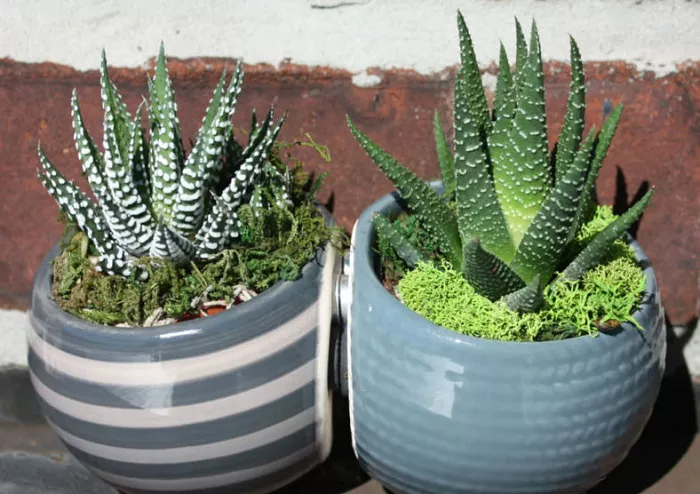Zebra succulent, also known as Haworthia Fasciata, is a charming and low-maintenance plant that can thrive with minimal attention. Its striking white stripes on dark green leaves make it a delightful addition to any indoor space. Whether you’re a beginner or an experienced gardener, this guide will help you keep your zebra succulent healthy and happy.
Understanding the Zebra Succulent
Zebra succulents are small, slow-growing plants native to South Africa. They have thick, dark green leaves with white tubercles that resemble zebra stripes. These plants are perfect for indoor gardening because they can tolerate a variety of conditions, including low light and infrequent watering.
Light Requirements
Zebra succulents prefer bright, indirect light. While they can survive in medium to low light conditions, they thrive when placed near a south or east-facing window. However, avoid exposing them to direct sunlight for extended periods, especially during the afternoon, as this can cause leaf burn. If you notice the leaf tips turning red or orange, it might be a sign that they are receiving too much light.
Watering Tips
Watering zebra succulents can be a bit tricky. These plants are sensitive to overwatering, which can lead to root rot. To avoid this, water your zebra succulent only when the top 25% of the soil is dry. When you do water, make sure to water thoroughly until water drains out of the pot’s drainage holes. It’s also important to remove any excess water from the saucer to prevent the plant from sitting in water.
During the growing season, which is typically from spring to fall, you may need to water your zebra succulent every 2 to 3 weeks. In winter, reduce watering to once every few months, as the plant’s growth slows down. Always check the soil moisture level before watering. You can use a moisture meter or simply stick your finger into the soil up to the second knuckle. If it feels dry, it’s time to water.
Soil and Potting
Zebra succulents require well-draining soil to prevent waterlogging. A cactus potting mix or a mixture of equal parts perlite, sand, and potting soil works well. When choosing a pot, make sure it has drainage holes to allow excess water to escape. Additionally, consider using a deep pot to accommodate the plant’s long root system.
Temperature and Humidity
Zebra succulents prefer temperatures between 60°F and 85°F (15°C to 29°C). They can tolerate warmer temperatures during the summer but should be protected from frost in the winter. If you live in a colder climate, it’s best to grow your zebra succulent in a pot so you can easily bring it indoors when temperatures drop.
These plants do not require high humidity and can thrive in average indoor humidity levels. However, if you notice the leaf edges turning brown, it might be a sign that the air is too dry. You can increase humidity by placing a tray of water near the plant or using a humidifier.
Fertilizing
Zebra succulents do not need frequent fertilizing. During the growing season, you can feed them with a balanced liquid fertilizer diluted to half the recommended strength once every 1 to 2 weeks. Avoid fertilizing during the winter months when the plant is dormant.
Propagation
Propagating zebra succulents is relatively easy and can be done through offsets or stem cuttings. Offsets are small plantlets that grow around the base of the mother plant. To propagate through offsets, gently twist or pull them off the mother plant, making sure to keep some roots intact. Allow the offsets to dry for a day or two before planting them in well-draining soil.
If you prefer to use stem cuttings, select a healthy stem that is at least 4 to 6 inches long. Allow the cutting to dry for a few days, then place it in a mix of perlite and moist peat. Cover the cutting with plastic to retain moisture and place it in a warm spot with indirect sunlight. After about 3 to 4 weeks, you should see new growth.
Common Problems and Solutions
Overwatering
Overwatering is one of the most common issues with zebra succulents. Signs of overwatering include mushy, discolored leaves and root rot. If you notice these symptoms, stop watering immediately and remove the plant from its pot. Gently clean off the wet soil and trim any affected roots. Allow the plant to air-dry for a few days before repotting it in fresh, well-draining soil.
Underwatering
Underwatering can cause the leaf tips to turn brown and dry. To address this issue, adjust your watering schedule to ensure the plant receives enough water. However, be careful not to overcorrect and end up overwatering.
Pests and Diseases
Zebra succulents are generally pest-resistant, but they can occasionally attract mealybugs. These pests can be removed by hand or treated with a standard houseplant insecticide. Root rot caused by poor soil drainage or overwatering is another common problem. To prevent root rot, always use well-draining soil and avoid overwatering.
Conclusion
Caring for a zebra succulent is relatively straightforward, making it an excellent choice for both beginners and experienced gardeners. By providing the right amount of light, water, and well-draining soil, you can enjoy the beauty of this unique plant for years to come. Remember to monitor your zebra succulent regularly for any signs of stress and adjust its care accordingly. With a little attention and patience, your zebra succulent will thrive and bring a touch of nature to your home.


